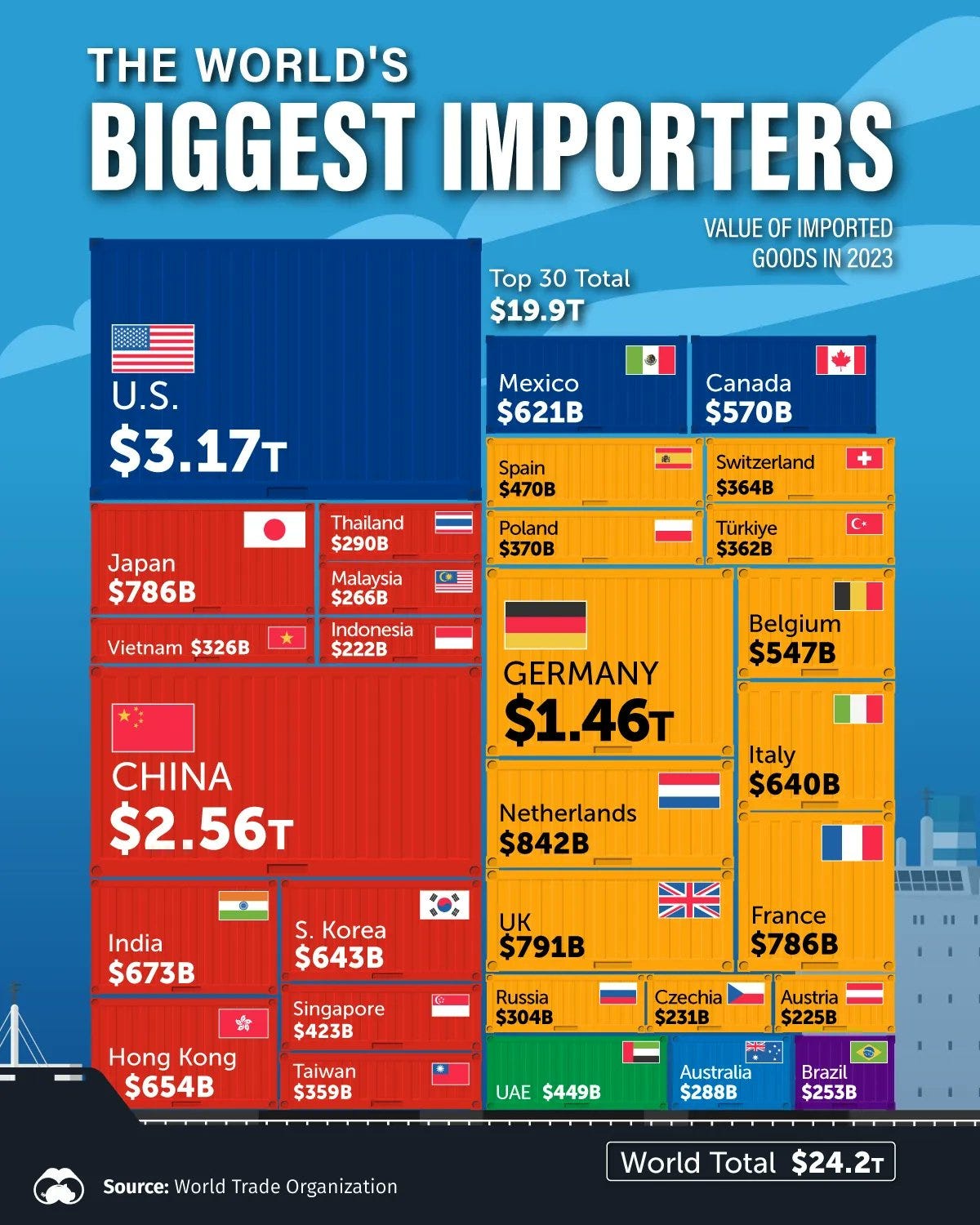How to Develop a Regional Supply Chain …If yours is not working - maybe it's time.
What companies need to consider to migrate globalized supply chains into a regionalized production and distribution strategy. Why? The rationale and a brief update on USA tariffs (as-of May 3, 2025)
Why Develop a Regionalized Supply Chain?
In an era of escalating tariffs and disrupted global trade, businesses face the challenge of rethinking their supply chains. When traditional global supply chains become unviable due to increased costs, delays, or geopolitical risks, developing a regional supply chain offers a strategic solution.
By sourcing materials, manufacturing, and distributing within a closer geographic area, companies can reduce costs, enhance resilience, and improve responsiveness to market demands.
This short guide explores the *how*—practical steps to localize your supply chain—and the *why*—the compelling benefits of agility, cost savings, and risk mitigation in a tariff-heavy world.
A Summary of Tariffs and Taxes (as of May 3, 2025)
Recent Tariffs and Port Taxes Impacting Supply Chains
Recent U.S. tariff policies and port-related fees, primarily targeting imports from China, Canada, Mexico, and other global trading partners, have significantly disrupted global supply chains, necessitating a shift toward regionalized and localized value chains.
Economic Impact
Tariffs are projected to raise consumer prices, with an estimated $1,300 average tax increase per U.S. household in 2025, contributing to inflation and potential economic slowdown.
(https://taxfoundation.org/research/all/federal/trump-tariffs-trade-war/) (https://www.jpmorgan.com/insights/global-research/current-events/us-tariffs)
U.S. Tariffs on Imports
Below is a concise summary of key tariff and port tax updates relevant to rebuilding supply chains:
China
As of April 2025, tariffs on Chinese goods have escalated to 145%, with some products facing up to 245% due to additional levies tied to fentanyl-related concerns. The elimination of the de minimis exemption for low-value goods (under $800) effective May 2, 2025, subjects these imports to duties of 90% or $75 per item, increasing to $150 after June 1.
These measures have led to a 45–60% drop in container bookings from China to U.S. ports, causing supply chain disruptions and potential retail shortages.
Source: (https://www.cbp.gov/newsroom/announcements/official-cbp-statement-tariffs)[](https://www.nytimes.com/live/2025/04/02/business/trump-tariffs-liberation-day)[](https://www.bbc.com/news/articles/cn93e12rypgo)
Canada and Mexico
Imports not complying with USMCA rules of origin face a 25% tariff, while energy products and potash outside USMCA preferences incur a 10% tariff.
USMCA-compliant goods are currently exempt, but non-compliant goods may face a 12% reciprocal tariff if exemptions end.
Source: (https://www.cbp.gov/newsroom/announcements/official-cbp-statement-tariffs)(https://www.ups.com/us/en/supplychain/resources/news-and-market-updates/2025-us-tariffs-impact-global-trade)
Other Countries
A baseline 10% tariff applies to most nations, with higher reciprocal tariffs (11–50%) subject to a pause of 90 days for 60 countries.
The EU faces a 20% tariff, and specific sectors like autos (25%), steel, and aluminum (25%) are also targeted.
Source: (https://www.bbc.com/news/articles/cn93e12rypgo)
(https://www.kiplinger.com/taxes/whats-happening-with-trump-tariffs)
Port Taxes and Fees
New port fees on non-U.S. ships, combined with tariffs, have exacerbated port congestion and empty container imbalances, particularly at West Coast ports like Los Angeles and Long Beach, where incoming vessels from China are down nearly 50%.
These fees, alongside a sixfold increase in blank sailings (canceled voyages), have reduced container volumes by 640,000–800,000 TEUs, straining logistics.
(https://prospect.org/economy/2025-04-24-permanent-tariff-damage/)
A Customs system glitch in April 2025 disrupted tariff exemptions for in-transit freight, increasing paperwork and costs for importers, further complicating supply chain operations.
(https://www.cnbc.com/2025/04/11/customs-reports-glitch-in-system-used-by-freight-for-tariff-exemptions.html)
Resources:
For detailed tariff schedules, refer to U.S. Customs and Border Protection updates at www.cbp.gov
(https://www.cbp.gov/newsroom/announcements/official-cbp-statement-tariffs)
In a nutshell….
How to Develop a Regional Supply Chain …if yours is not viable, at risk, or could be better.
Secure land:
Preferably co-located within vertically integrated region of manufacturing specialization
Build factories:
Invest in new, renewed, or repurposed buildings and facilities for local operations
Procure equipment:
Select and finance required production equipment to meet budgetary constraints and provide maximum return on revenue
Hire and train workers:
Incentivize relocation of talent from other locations or invest in regional upgrade of existing labour for the purpose of production while weighing the time and cost of both options with demand.
Establish logistics network:
Plan requirements and outsource contracts or develop customer delivery services to best meet demand to maintain capacity and limit inventory carrying costs.
Manage imported materials:
Substitute, source, or remove production of goods (SKU) and services which require inputs that are unavailable regionally, are too risky, or cost-prohibitive to maintain.
Rebuilding a Supply Chain
Is this easy? No.
Is it guaranteed? No
Is it necessary? No
What are the Alternatives?
Options for companies facing tariffs which substantially change their business operations include adaptation, continuation, or transformation.
➡️ Wait and see.
➡️ Stop and sell.
➡️ Manage and adapt.
➡️ Blend of all-of-the-above.
Implications for Supply Chain Rebuilding
Why Localize?
High tariffs and port fees make importing cost-prohibitive, especially from China, pushing businesses to source materials and manufacture closer to their markets. Regional supply chains reduce exposure to tariff volatility, shorten lead times, and mitigate risks from global trade disruptions.
Strategies
Companies can leverage USMCA exemptions by sourcing from Canada or Mexico, invest in domestic production to avoid tariffs, or partner with regional suppliers to build resilient value chains. Diversifying supplier bases within the Americas or near-shoring to Central America can also offset port congestion and fee-related costs.
These tariff and port tax dynamics underscore the urgency of transitioning to regional supply chains to enhance cost efficiency, agility, and stability in a tariff-heavy trade environment.
Let us know what you are doing to manage, adapt, or hold your business and adjust to new challenges.
You might also like…
“Planning for Production” by Supply Chain Logistics Consulting
https://supplychainlogistics.net/2025/01/08/starting-out-planning-for-production/
Supply Chain Logistics Consulting
Find more resources on our website and through your preferred social media.
Contact us to help with your strategic supply chain operations project.
#supplychain #production #localization #expansion #strategicbusiness #pivot










